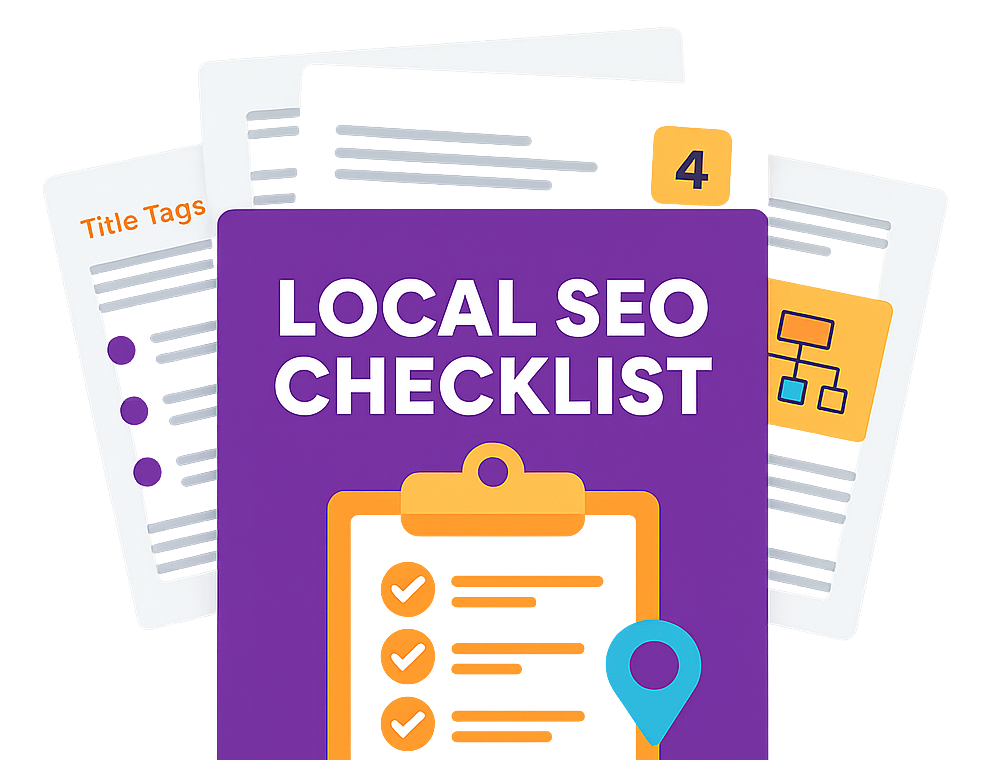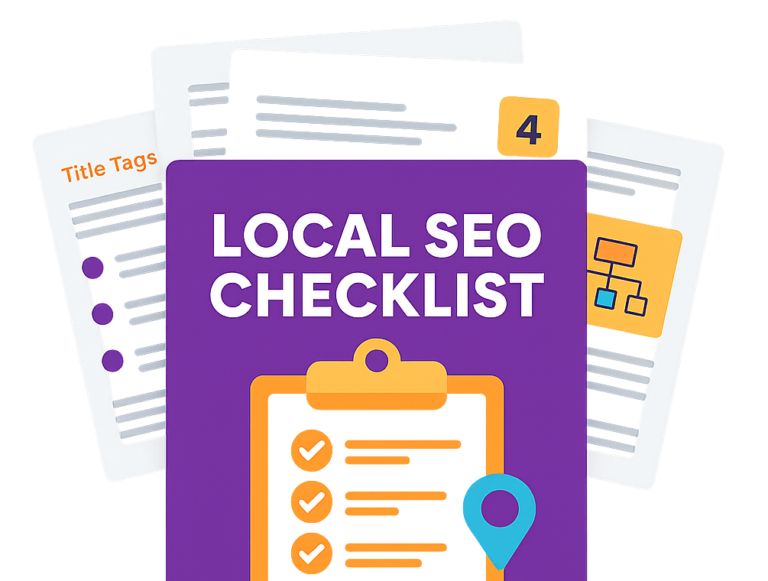Technical SEO is all about optimising the infrastructure of your website so that search engines can find, understand, and ultimately rank your pages. It’s the essential groundwork that makes sure your brilliant content actually gets discovered by an audience.
Think of it like the foundation, plumbing, and wiring of a house. Without those solid fundamentals in place, even the most beautiful interior design will go completely unnoticed.
Understanding Technical SEO From the Ground Up

If on-page SEO is about your content and off-page SEO is about building authority with backlinks, then technical SEO is the work you do behind the scenes. Its focus is purely on how well search engine bots can access, crawl, and index your website.
Imagine you’ve written the most helpful article in the world. If a technical barrier stops Google’s crawlers from finding it, accessing it, or figuring out what it's about, it simply won't appear in the search results. It’s as good as invisible.
This is why a technically sound website is the non-negotiable first step for any serious online presence.
The Core Goal of Technical Optimisation
At its heart, the goal is to remove any technical roadblocks that might stop a search engine from doing its job effectively. A well-optimised site essentially speaks Google's language, making it incredibly easy for bots to see its value and purpose.
This work breaks down into a few key areas:
- Crawlability: Can search engine bots easily explore all the important pages on your site without hitting dead ends or getting stuck in loops?
- Indexability: Once your pages are crawled, can they be successfully added to Google’s massive library (the index) so they can be shown in search results?
- Performance: Does your site deliver a fast, secure, and seamless experience for visitors, especially on mobile? This is a direct ranking factor.
To give you a clearer picture, here’s a quick breakdown of the core pillars and what they aim to achieve.
The Core Pillars of Technical SEO
| Pillar | Primary Goal |
|---|---|
| Site Architecture | Create a logical, easy-to-navigate structure for both users and search engines. |
| Crawl & Index | Ensure search engines can discover and add all important pages to their index. |
| Site Speed | Deliver a fast-loading experience to reduce bounce rates and improve rankings. |
| Mobile-Friendliness | Provide a seamless experience on smartphones and tablets, which is critical for ranking. |
| Security | Protect user data with HTTPS to build trust and meet Google’s standards. |
| Structured Data | Use schema markup to help search engines understand your content more deeply. |
These elements work together to create a website that search engines not only trust but also want to recommend to their users.
Why It Matters for UK Businesses
The focus on a website’s technical health is only growing. It’s projected that in 2025, nearly 48% of UK businesses will have integrated technical SEO as a fundamental part of their strategy. This shift shows a clear recognition that elements like site speed and mobile-friendliness directly impact rankings and, more importantly, user experience.
If you want to dive deeper into the nuts and bolts, we recommend checking out a comprehensive technical SEO guide.
Technical SEO isn’t just a job for developers. It's the responsibility of anyone who wants their website to succeed. A slow, confusing site frustrates both users and search engines, leading to lower rankings and lost opportunities.
Ultimately, strong technical optimisation ensures that all your other marketing efforts—from content creation to social media campaigns—are built on a solid, reliable foundation. To see how all the pieces of the puzzle fit together, you can explore our detailed guides in the Bare Digital SEO Hub.
Why Technical Health Is Non-Negotiable for UK Businesses
Let's be blunt: in today's digital world, solid technical SEO isn't just a "nice-to-have" for UK businesses. It's the absolute bedrock of your online survival and growth. We've covered the 'what' of technical SEO, but it's the 'why' that really hits home. A technically sound website directly shapes how both customers and search engines see your brand.
Think about it in real-world terms. A slow-loading e-commerce site haemorrhages sales during peak shopping hours as frustrated buyers simply give up and go elsewhere. Or imagine a local tradesperson in Cambridgeshire with a clunky, unresponsive mobile site—they’re bleeding valuable leads from customers searching for help on their phones.
These aren't just minor glitches. They are critical business failures.
The Direct Impact on Business Outcomes
Strong technical health feeds directly into tangible business results. Search engines like Google now place a massive emphasis on user experience, making factors like site speed and mobile-friendliness direct, heavy-hitting ranking signals.
A technically sharp website gets several crucial things done:
- Lower Bounce Rates: When your pages load in a snap and are easy to get around, people stick around. They're far more likely to explore what you have to offer instead of hitting the back button.
- Higher Engagement: A smooth, intuitive site experience encourages people to click, read, and interact. They'll view more pages and spend more time getting to know your business.
- Better Conversion Rates: At the end of the day, a positive user experience builds trust and removes friction. It makes it easier for a visitor to take that final step, whether that's clicking "buy now" or filling out a contact form.
For UK businesses, skimping on technical SEO is like inviting customers into a shop with flickering lights and cluttered, messy aisles. It doesn’t matter how fantastic your products are; the terrible experience will drive people away before they even have a chance to buy.
This link between technical performance and user happiness isn't just a theory anymore—it's something Google explicitly measures.
Meeting Google’s Performance Standards
Google’s focus on Core Web Vitals has made technical SEO a mission-critical factor for any website targeting the UK market. These vitals directly connect your site's performance to user experience and, in turn, your search rankings.
It all boils down to a set of key metrics: Largest Contentful Paint (LCP) measures loading speed, First Input Delay (FID) checks for interactivity, and Cumulative Layout Shift (CLS) assesses visual stability. UK websites that don't hit the recommended targets for these metrics don't just see their rankings suffer; they also watch their bounce rates climb as users, accustomed to fast and seamless browsing, lose patience. You can learn more about why SEO is more than keywords by reading this detailed analysis of search engine priorities in 2025.
Ultimately, investing in your site’s technical health ensures it’s not just visible but actually effective. It’s about turning your web traffic into real business opportunities by creating an environment where users feel valued and confident. For any UK business serious about succeeding online, this foundation is completely non-negotiable.
Your Essential Technical SEO Audit Checklist
A hands-on technical SEO audit can feel like a massive task, but if you break it down into manageable chunks, the whole process becomes much more straightforward. This checklist covers the core components, giving you a systematic way to analyse your website’s technical health and find any critical issues that could be holding you back.
Think of it as a health check for your website's very foundations. When you work through these points methodically, you’re creating a clear roadmap for improvements that will directly lead to higher rankings and a much better experience for your users.
If you want an even more granular breakdown, our comprehensive technical SEO audit checklist with 15 essential elements offers a deeper dive into the process.
Crawlability and Indexability
First things first, you need to be absolutely sure that search engines can actually find and understand your content. It’s simple: if Google can't crawl or index your pages, nothing else you do will matter.
- Check
robots.txt: This small but mighty file tells search engines which parts of your site they can and cannot crawl. Make sure you aren't accidentally blocking important pages or resources. A single wrong line here can make entire sections of your site invisible. - Analyse Your XML Sitemap: Your sitemap is essentially a map you give to search engines. It needs to be error-free, up-to-date, and submitted to Google Search Console. Critically, it should only list the valuable pages you actually want to be indexed.
Site Architecture and Navigation
A logical site structure is a win-win. It helps your users find what they need easily, and it helps search engines navigate your website efficiently. A disorganised, messy site can confuse crawlers and water down the authority of your most important pages.
A clean, logical site architecture is one of the most underrated aspects of technical SEO. It ensures that 'link equity' flows correctly through your site, signalling to Google which pages are the most important.
When you're planning significant structural changes or platform updates, incorporating a thorough plan for effective code migration strategies into your audit is crucial. It ensures a smooth transition and helps you avoid nasty SEO pitfalls down the line.
Site Speed and Core Web Vitals
There's no getting around it: site speed is a confirmed ranking factor and absolutely vital for user experience. Pages that load at a snail's pace lead to high bounce rates and, ultimately, lost business. Your main focus here should be on Google's Core Web Vitals.

This image perfectly illustrates the direct link between site speed (the stopwatch) and a positive user experience (the smooth loading bar). Optimising for speed is a fundamental part of any technical SEO audit because it directly impacts how both users and search engines perceive your site's quality.
Common Technical SEO Issues and Their Solutions
When you start digging into a technical audit, you'll likely run into a few common culprits. Don't worry, most of them have straightforward fixes. Knowing what to look for can save you a ton of time and frustration.
Here’s a quick troubleshooting guide to some of the most frequent problems we see and how to sort them out.
| Common Issue | Why It's a Problem | How to Fix It |
|---|---|---|
| Duplicate Content | It confuses search engines about which version of a page to rank, diluting your SEO authority. | Use canonical tags (rel="canonical") to point Google to the preferred version of the page. You can also use 301 redirects for consolidated content. |
| Broken Internal/External Links | Broken links create a poor user experience and stop the flow of link equity around your site. | Run a crawl of your website using a tool like Screaming Frog to find all 404 errors. Update or remove the broken links. |
| Missing Alt Text on Images | Images without alt text are invisible to screen readers (hurting accessibility) and search engines (missing out on image search traffic). | Audit your images and add descriptive alt text that explains what the image shows. Include relevant keywords where it feels natural. |
| Thin Content | Pages with very little useful content are seen as low-quality by Google and are unlikely to rank for competitive terms. | Identify these pages and either improve them with more substantial, valuable content or consolidate them into a more comprehensive page. |
| Improper Redirects | Using 302 (temporary) redirects instead of 301 (permanent) ones can prevent link equity from being passed correctly. | Review your redirects and ensure all permanent moves use 301 redirects. Use 302s only for genuinely temporary changes. |
This table isn't exhaustive, of course, but it covers the low-hanging fruit that can often make a surprisingly big impact once fixed. Regularly checking for these issues is a core part of maintaining good technical site health.
Mobile-Friendliness and Security
With the vast majority of searches now happening on mobile devices, having a flawless mobile experience isn't just a nice-to-have; it's completely non-negotiable.
- Responsive Design: Your website absolutely must adapt seamlessly to all screen sizes, from big desktop monitors right down to the smallest smartphones. Use Google's Mobile-Friendly Test to get a quick check on your pages.
- HTTPS Security: Your site must use HTTPS. It secures the connection between your users' browsers and your server, which builds trust and satisfies a key Google requirement. An SSL certificate is essential for any modern, credible website.
How Structured Data Prepares You for AI Search
As search technology barrels forward, we have to look at what's next. A huge piece of modern technical SEO is structured data, which is usually implemented with something called Schema markup.
Think of it as a secret language that helps search engines and AI assistants understand the context of your content, not just the words on the page.
Imagine your website’s content is all the food in your kitchen. Structured data is like putting a label on every single ingredient, telling a visiting chef (like Google's AI) exactly what you have. This lets the chef instantly create a sophisticated dish—like a rich snippet or a detailed AI Overview in the search results.
This isn’t a niche tactic anymore. For UK businesses, adding schema for things like 'LocalBusiness', 'Product', or 'Article' is a strategic move to stay visible.
Why It Matters for AI and Zero-Click Searches
The way people in the UK search is changing, and it's having a profound impact on technical SEO. The biggest driver is the rise of zero-click searches, with some estimates suggesting they will affect 58% to 60% of all queries by 2025.
What does that mean? It means most users will get their answers directly from the search results page without ever clicking through to a website. This shift is fuelled by AI-powered features like Google's AI Overviews, which piece together information right there in the search interface.
Structured data feeds these AI engines the precise, organised information they need to feature your business. Without it, you risk becoming invisible in this new search environment. AI will simply struggle to understand and trust your content enough to present it as an authoritative answer.
Preparing Your Site for Tomorrow's Search
Getting this right is how you prepare your website for the next generation of search. By clearly defining your content’s meaning, you’re essentially future-proofing your online presence.
Here's how it works in practice:
- For E-commerce: Use 'Product' schema to spell out details like price, stock levels, and customer reviews. This can get your products featured directly in AI-powered shopping results.
- For Local Businesses: 'LocalBusiness' schema can highlight your address, opening hours, and phone number, making it a breeze for AI assistants to recommend you.
- For Content Publishers: 'Article' schema helps identify authors and publication dates, which signals your expertise and how current your information is to search algorithms.
Getting to grips with these elements is crucial. As you start to integrate these practices, it's also worth exploring how AI for SEO can sharpen your strategy even further. In the end, properly structured data makes your site a prime candidate for visibility in an AI-driven world.
Building Your Technical SEO Toolkit
You don’t need to be a developer to get a handle on technical SEO, but you absolutely need the right tools in your corner. A solid toolkit makes spotting and fixing your website's underlying issues a much smoother process. The right software can take complex, messy data and turn it into clear, actionable advice.
And this isn't about breaking the bank; many of the most powerful tools are completely free. The real secret is knowing which ones to use and, more importantly, why you're using them. A smart selection lets you cover everything from a quick health check to a deep, granular analysis of how your site is performing.
Essential Free Tools From Google
Google itself provides a suite of free tools that deliver the foundational data every UK website owner needs. Honestly, these should be your first port of call.
- Google Search Console: Think of this as your direct line to Google. It shows you exactly how the search engine sees your site, flagging crawl errors, security problems, and indexing roadblocks. For anyone serious about SEO, using it is non-negotiable.
- PageSpeed Insights: This tool dives into your site’s performance on both mobile and desktop. It gives you a score based on Core Web Vitals and, crucially, offers specific, practical recommendations for how to improve it.
Take a look at the Google Search Console homepage. This is your command centre for understanding your site's performance straight from the source.

This dashboard is so important because it provides indispensable data on how Google crawls and indexes your site. It’s the bedrock of any technical SEO work.
All-in-One SEO Platforms
For a more comprehensive view, all-in-one platforms automate site audits to dig up problems that you might otherwise miss.
While Google's tools are essential for monitoring what’s happening, platforms like Semrush or Ahrefs are brilliant for proactively finding and solving problems. They crawl your entire site—just like a search engine would—and hand you a prioritised list of technical fixes.
These platforms check for hundreds of potential issues, from simple broken links and messy redirects to tricky duplicate content problems. They wrap all this information into easy-to-digest reports, saving you countless hours of manual digging. For a more hands-on approach, you can master technical SEO services for your website by learning to interpret this data effectively yourself.
Specialised Crawling Software
Finally, for those times when you need to go incredibly deep with your analysis, specialised crawlers are the answer.
A tool like the Screaming Frog SEO Spider is a powerful desktop program that crawls your website’s links, images, CSS, and scripts from a pure SEO perspective. It’s the tool of choice for in-depth technical audits, letting you analyse page titles, hunt down duplicate pages, and build XML sitemaps with absolute precision.
Right, let's clear up some of the common questions that pop up when UK business owners start getting to grips with technical SEO. Even when you understand the theory, putting it into practice always brings up a few head-scratchers.
This section tackles those frequently asked questions, bridging the gap between knowing what technical optimisation is and feeling confident enough to apply it.
How Often Should I Perform a Technical SEO Audit?
For most UK businesses, a full technical SEO audit every 6 to 12 months is a solid rule of thumb. Think of it like your car's annual MOT – it's a scheduled, deep dive to make sure everything's running smoothly and to catch small issues before they turn into major problems.
But that's not a hard-and-fast rule.
If you’re running a large e-commerce site with thousands of products, or you’re constantly adding new content, a quarterly check-up is a much smarter move. The more moving parts your website has, the more chances there are for things to go wrong.
Beyond those scheduled audits, you should be keeping a regular eye on your digital dashboard—Google Search Console. Watch out for any warning lights, like a sudden spike in crawl errors, new security flags, or mobile usability issues. Those are the kinds of things that need your immediate attention.
Can I Do Technical SEO Myself or Do I Need a Specialist?
This really boils down to two things: your website's complexity and your own comfort level with the technical side of things. Many business owners are more than capable of handling the basics, especially on user-friendly platforms like WordPress.
Tasks you can probably manage on your own include:
- Optimising Title Tags and Meta Descriptions: Writing clear, snappy text for your page titles and the little descriptions that show up in search results.
- Compressing Images: Using simple plugins or online tools to shrink image file sizes so your pages load faster.
- Generating a Sitemap: Letting a plugin like Yoast or Rank Math create and update your XML sitemap for you.
However, once you start venturing into the more complex stuff, it’s often wise to call in an expert.
For the deeper issues – things like JavaScript rendering, serious Core Web Vitals optimisation, complex redirect mapping, or messing with server configurations – a specialist's experience is invaluable. Trying to fix these without the right expertise can easily make things worse.
A good starting point is to run your site through Google's PageSpeed Insights. If the report comes back with a list of issues that look like they're written in another language, that's a pretty clear sign it's time to talk to an SEO specialist or a web developer.
What Is the Difference Between Technical SEO and On-Page SEO?
This is a classic point of confusion, but a simple analogy clears it right up.
Imagine your website is a house.
Technical SEO is the foundation, the wiring, and the plumbing. It’s all the behind-the-scenes structural work that makes the house stable, safe, and easy for people (and search engine bots) to get into and move around. It makes sure the lights switch on, the doors open, and the whole structure is sound.
On-page SEO is the interior decorating. This covers the content and design choices you make inside each room (or on each page). It’s all about arranging your keywords, headings, images, and text to be relevant, engaging, and perfectly suited to your visitors.
You can have the most beautifully decorated room in the world, but if the house has a dodgy foundation and nobody can get in the front door, none of that effort matters. They are two different jobs, but they absolutely depend on each other for success.
How Does Technical SEO Support My Other Marketing Efforts?
Technical SEO isn't something you do in a vacuum; it’s the engine that powers your whole digital marketing machine. A technically solid website acts as a massive amplifier for all your other promotional work, making sure your time and money aren't going to waste.
Think about how it links up with other channels:
- Content Marketing: It makes sure your brilliant blog posts and guides can actually be found, indexed, and ranked by Google in the first place.
- Paid Search (PPC): It gives your Google Ads campaigns a direct boost. Google rewards ads that point to fast, secure, and user-friendly landing pages with a higher Quality Score. That can mean lower costs per click and better ad positions for you.
- Social Media: It makes your social strategy work better. When someone clicks a link from Facebook or LinkedIn, a good technical setup ensures they have a smooth, positive experience on your site, encouraging them to stick around, convert, or share your content.
Ignoring technical SEO is like trying to drive a performance car with a flat tyre. No matter how powerful the engine is, you're not going anywhere fast. It ensures the foundations are solid so that every other part of your marketing can deliver its best performance.
At Bare Digital, we demystify technical SEO for businesses across Cambridgeshire and the UK. If you want a clear, no-nonsense plan to improve your site's foundations and boost your rankings, get in touch. We offer a free SEO Health Check to get you started. Find out more at https://www.bare-digital.com.








